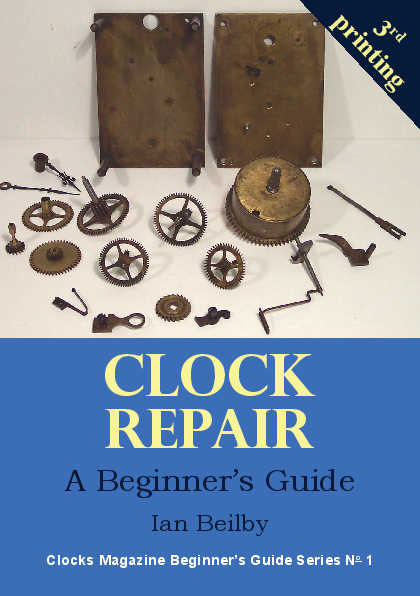
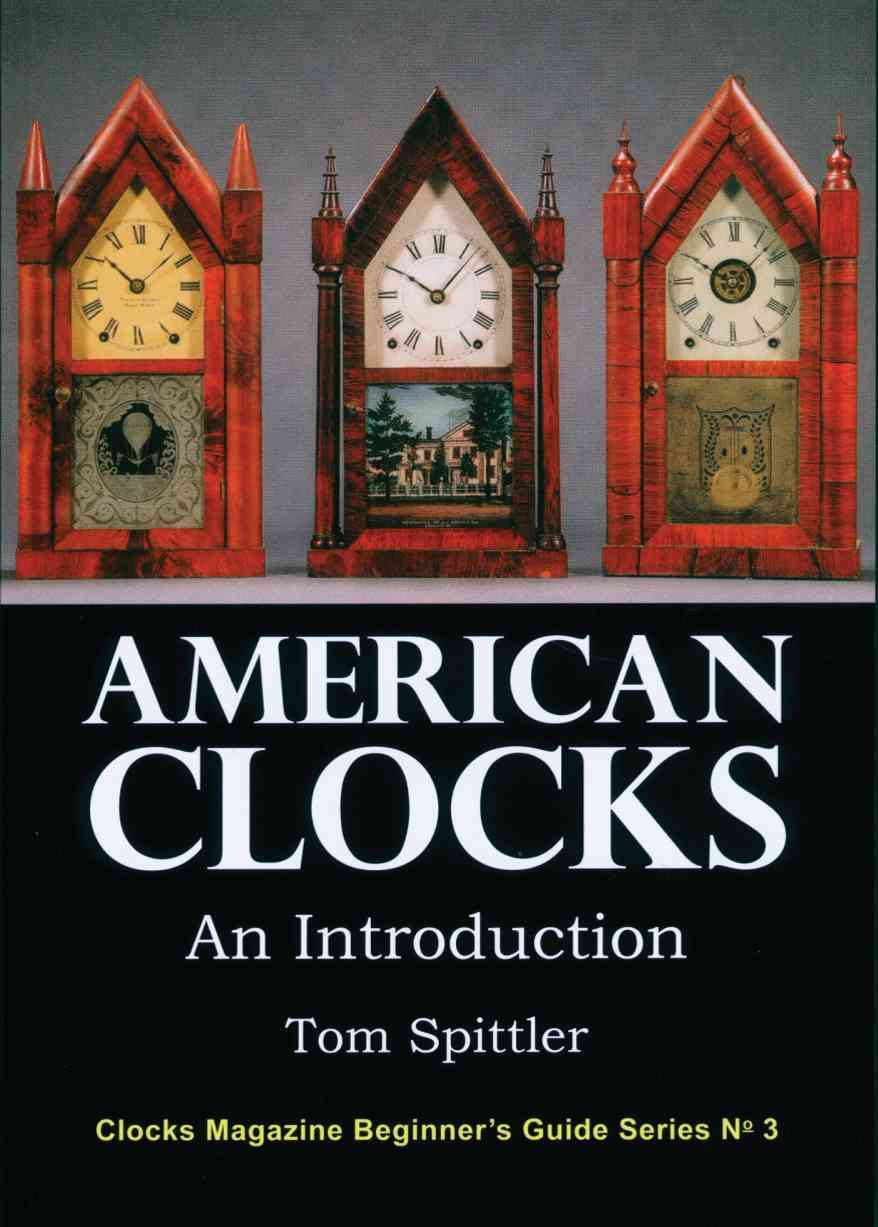

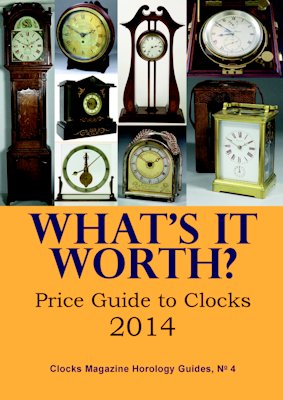
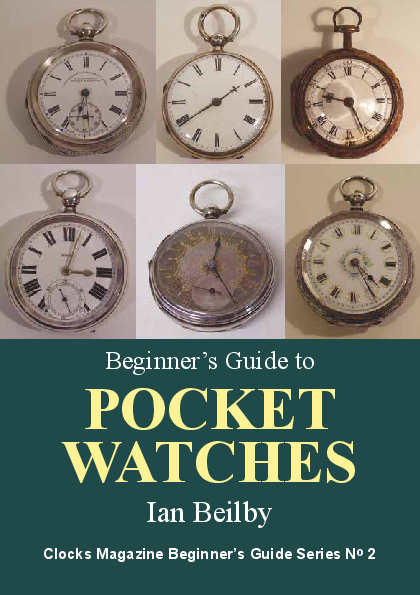
|
|
| from Clocks Magazine, Sepember 2004 | |
Positively cuckooby Brian Barkworth, AustraliaDownload a pdf of this article I like the idea of the cuckoo clock. I like the whole Black Forest story—the myths and legends that have grown up around it seem splendid to me. But the modern touristy versions of the cuckoo clock can be a bit trying at times. I often tell owners of modern eight-hour cuckoo clocks not to expect too much of them as clocks, but to enjoy them for the pleasure that they obviously give doing their thing hanging on the wall. Figure 1 shows an architectural style of cuckoo clock, c1880 and made by GHS (Gordian Hettich Söhne) with a substantial single fusee, spring-driven brass-plate movement and cuckoo-and-gong striking. The large case was of oak in a natural finish with very nice carving. Most cuckoo clocks seen today are hanging weight-driven wall clocks and the mantel style spring-wound version is rarely seen. The architectural style, with gable roof top and ornamental fretted and carved base and front was obviously a popular style and marketed by several makers in a similar pattern. Ortenburger’s book Black Forest Clocks shows an identical clock on p83. Kochmann’s The Black Forest Clockmaker and the Cuckoo Clock shows a similar example on p189, plate 213, where it is listed as a fusee eight-day movement in an oak case selling for £4 10 0d (£4.50) in 1914. This particular clock was not going or striking, and a quick appraisal showed that it had acquired a French pendulum, had plastic hands instead of bone ones, and that there were several cracks around the case and especially a large crack right through the dial and case. Both bellows were unserviceable, the back door gong was missing, all the linkages were non-original and six turned pediments were also missing. 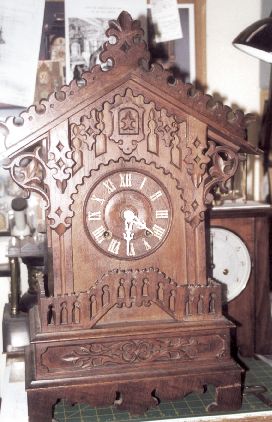

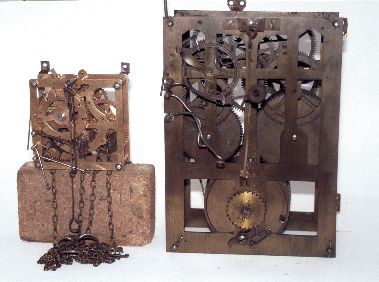

Research in Ortenburger and Kochmann showed that cuckoo clocks date from around 1730 and that by 1800 there was a thriving industry and an incredible range of cuckoo clocks were being produced. Most cuckoo clocks were weight-driven and the closed pipes used the notes A and F below middle C. The goatskin bellows were lifted by wires, in turn triggered by a pin-wheel in the notched count wheel train. On release, the bellows fell back to make the ‘cuck-oo’ sound. The bird moved forward and thus opened the door. Another wire, fastened to one of the bellows, caused the bird to open its beak and flap its wings. Kochmann’s book, p101, has a clear, simple diagram of the sequence. As well as cuckoos, there were quails, trumpeters, spiral gongs and musical boxes and all of these can be seen in the modern equivalents that are for sale today. Antique cuckoo clock cases were made of beech or linden (lime or basswood) which were all good carving woods, with walnut or oak also being used. Spruce was favoured for the backboard because of its superior sounding qualities. The earliest movement plates and gears were also made of beechwood. Wooden plates and brass wheels appeared around 1840, cast brass movements around 1865 and stamped movements around 1900. However, the early history of the invention of the cuckoo clock and its makers is shrouded in contradiction and myth. A search through the past indexes of Clocks magazine will find several articles and references to the Black Forest, cuckoo clocks, their repair and their history. For example, the May 2000 issue has an article by Simon Drachman which discusses and compares a clock by Beha and one by Gordian Hettich & Söhne, the latter being the maker of the clock which is the subject of this article. So I will focus my article on a description of the restoration of the clock, and some of its parts, which may prove useful to the reader. After removing the bellows pipes and connecting wires from the case, the movement was also removed and appeared in good condition with nothing missing or broken, figures 2 and 3. It was heavy and substantial, 7.5in by 5in and 2in between the plates, figures 4, 5, 6 and 7. It was serviced in the usual manner, described many times in Clocks. It was stripped into its component parts, washed in a cleaning solution, rinsed and dried. 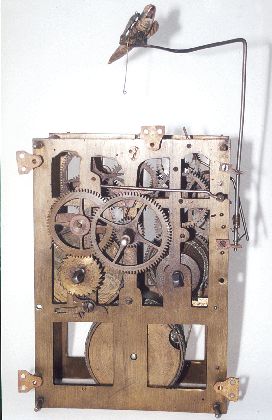

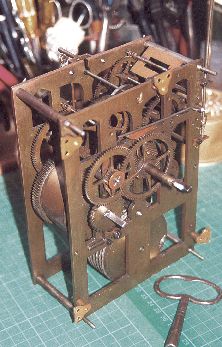
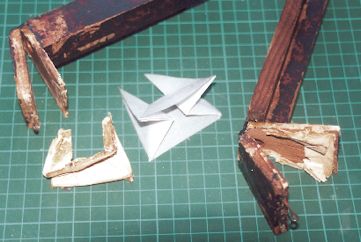
The brass parts were scrubbed with Brasso and polished. The leaves and wheel teeth were brushed, arbors lightly polished with fine emery paper, pivots and escapement pallets burnished and bearing holes pegged out. The fusee cable was in good condition and was re-used. After oiling, the movement was set up for testing and, thankfully, no surprises were found. A plain bob of the sort seen in illustrations of contemporary examples was made up and substituted for the French Brocot type of bob. A cuckoo clock has a lot of ancillaries and a lot of attention was needed here. A book by Phillip Balcomb, a Star Fellow of the nawcc, called The Clock Repair First Reader and published by Tempus Press has a lot of useful repair information on cuckoo clocks. The bellows, figure 8, which I think were original, had been repaired, patch-upon-patch, and were rotten and torn. The activating wires were definitely non-original and were just twisted into place. Dealing with the bellows first, the original remains were very carefully removed from the pipes so that they could be used as some sort of a pattern. Don’t forget, when removing the pipes, to mark them ‘left’ and ‘right’ because they sound different notes. Replacements for bellows, or complete pipes, are cheaply available for modern cuckoo clocks but antique clocks have much larger pipes and the bellows are not rectangular but are more fan shaped. I use the special paper sort of fabric that is available from suppliers when making up modern bellows but for this clock I found some incredibly thin leather. It was a discarded exotic piece of ladies’ wear. I love the thought of it going ‘cuckoo, cuckoo’ in its recycled role! The leather was cut and folded to the pattern, figure 9. You will have to lightly iron in the folds or creases and then the fiddly task of gluing and fitting the bellows in place will be helped by liberal use of swear words. Some trimming will be required especially where the points of the skin fold around the back of the bellows. You will be well rewarded for your patience when the pipe is born again and makes its first sound. Substitutes for the small weights found under the papered-over top flap of the bellows can be made by hammering flat small spherical lead fishing weights. 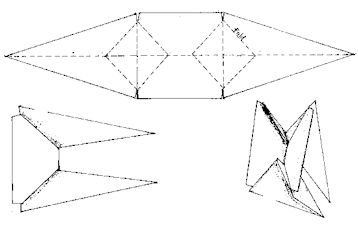


Most pipes are papered over with a mottled paper in various colours. I don’t know if it was intentional, but the Mart journal, put out with the NAWCC Bulletin, used to have a cover with this mottled pattern, figure 10. I photocopied this in a variety of colours and use this to re-paper any pipes that need it. The activating wires were made up to the approximate lengths of the found wires but, as you would expect, there was quite a bit of trial and error when fitting them later. The wires look deceptively simple but don’t be tempted to ‘improve’ on them by making closed links and suchlike because the Black Forest craftsmen have spent years refining the ‘hook’ and ‘crook’ shape. Soft wire is not suitable and you will need to find a springy but flexible wire, figure 11. The cuckoo, figure 12, had also suffered much at the hands of time (sorry) and was given delicate surgery to restore the beak movement, replace some of the wires and touch-up the paint. The antique cuckoos were larger and more complicated than the modern version. Ortenburger shows a variety of antique cuckoos on pp88-90 of his book, with advice on how you can date them by the type. Meanwhile, the oak case was also receiving attention. Referring to the illustration in Kochmann, it had lost several finials. They were not very complex, in fact, they were of rather uninspiring (sorry again) shape and were easily turned up from a length of dowel and stained to match, figure 13. A couple of spares were also made for the owner of the clock. The front of the case had split vertically right through and included the turned wooden dial. The split had been puttied-up in a rough and visible manner. Several of the carved and decorative parts of the case had, likewise, been broken and poorly repaired, giving a generally scruffy appearance to the case. 
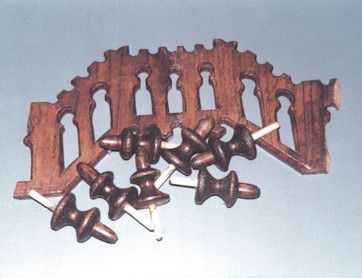

I carefully cleaned out the split and filled it with a mixture of pva glue and oak sawdust. I have several small jars of sawdust of different woods and hues, and find they work well as an alternative to commercial wood filler. If you are going to add stain it works well to add it at the same time. A length of bandage-like tape, used in bookbinding, was glued inside the case to give strength and discourage further opening of the split, figure 14. The fretted parts were removed where necessary and re-fitted and similarly filled with the sawdust/glue filler so that the repairs were less noticeable. The turned oak dial had the original bone numerals but many were loose and there were a few broken corners. The re-pinning and cleaning was a slow and careful operation but the finished result was well worth the effort, figure 15. The hands, however, were modern plastic replacements. I dallied with thoughts of attempting to make replacements out of bone, but the reality of the customer paying for my making them soon had me making the best of it by filing and shaping the flat plastic hands into something more sympathetic to the originals. A quick wiping on and off of stain, to add some dimension to the modelling, gave a quite pleasing result and was a big improvement. The winding hole grommets still had a few bits clinging to the holes and there was enough to work out the original size and shape, so I turned up new ones from a bone-coloured nylon material that had been used to make up vintage car suspension bushes. The missing coiled gong was replaced with a new, large-size, modern replacement and screwed, as is usual, to the removable backboard. 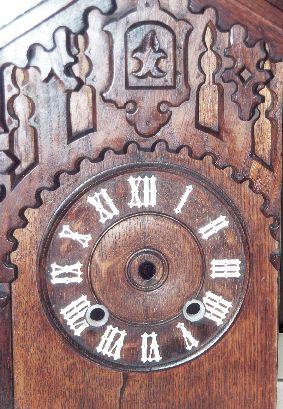
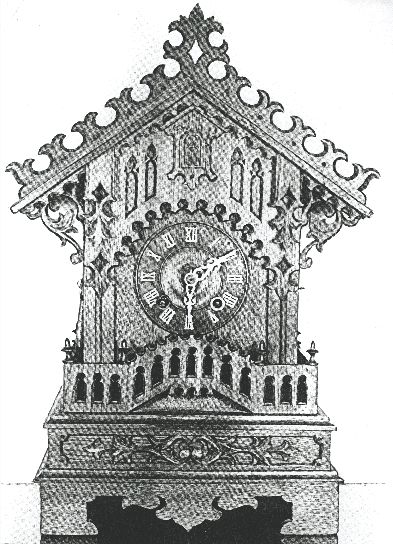
Following the adage ‘the best repairs are those which are least noticeable’ I then lightly cleaned and rubbed down the case—not an easy task with all the carved and fretted detail—and gave it a freshen-up with a dilute mix of walnut/oak stain. The following day, a coat of black wax was brushed up into a nice glowing finish without making the case look in any way new. This completed the restoration and the clock was re-assembled. Then followed the aforementioned fiddling to get the length of the activating wires correct and the operation of the pipes and cuckoo working at their best. One of the satisfactions I find in working with antique clocks, as opposed to working on more modern clocks, is the challenge often posed in the restoration. There are decisions and uncertainties and the creative process is much in evidence. The responsibility is scary too, at times! Often a bit of time has to be allowed for mulling over problems and solutions and this results in much satisfaction especially if the result is what you wanted. As I do with most antique clocks, I made up a folder detailing the restoration and including ‘before’ and ‘after’ photographs and some history of the maker or type of clock. This is usually very enthusiastically received and results in the owner being more aware and knowledgeable and even more in love with his or her clock than before the ailing heirloom was brought to the workshop. References 1. Black Forest Clocks by Rick Ortenburger, Schiffer Publishing. 2. The Black Forest Clockmaker and the Cuckoo Clock by Karl Kochman, Antique Clock Publishing 3. The Clock Repair First Reader by Phillip E Balcomb, Tempus Press, USA. 4. Clocks, May 2000, pp29-32, and other issues. Download a pdf of this article © 1977 to 2015 Clocks Magazine & Splat Publishing Ltd | |